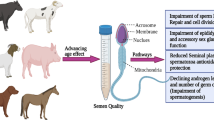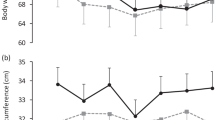Abstract
The XY Sex Reversal Syndrome of the horse is a condition associated with female or intersexual development in genetic males. In our previous study, 38 sex reversed XY mares were classified according to behavior, gross clinical phenotype, gonadal status, and H-Y phenotype. Four classes were described, ranging from potentially fertile female (Class I) to virilized intersex (Class IV). In the present study, serum testosterone concentrations were measured in 29 sex-reversed XY mares, 3 normal mares and 3 normal stallions. Serums were obtained during the breeding season (March-August), and were stored at − 70 C until assayed. Serum testosterone concentrations in the normal XX mares ranged from nondetectable to 0.41 ng/ml; in normal XY stallions, from 1.04 ng/ml to 2.4 ng/ml; and in XY mares, from nondetectable to 5.4 ng/ml. Sex reversed mares previously assigned to Class I or II had serum testosterone concentrations ranging from nondetectable to 0.22 ng/ml, whereas Class III and IV intersex mares had concentrations ranging from 0.43 to 5.4 ng/ml. Serum testosterone concentrations in XY mares were correlated with sex phenotype and behavior. Although the range of steroid concentrations among XY mares may be quantified more accurately with increased sampling, serum testosterone concentrations can be used currently as an added parameter for study of the sex reversed condition.
Similar content being viewed by others
References
Kent M.G., Shoffner R.N., Bueon L., Weber A.F. XX sex reversal syndrome in the domestic horse. Cytogenet. Cell Genet. 42: 8, 1986.
Kent M., Wachtel S. Development of the XY female: a comparative study. In: Wachtel S. (Ed.), Evolutionary mechanisms in sex determination. CRC Press, Boca Raton, in press.
McDonnell S. Reproductive behavior of the stallion. Vet. Clin. Nort. Am.: Equine Practice 2: 535, 1986.
Turner J.W.Jr., Kirkpatrick J.F. Androgens, behavior, and fertility control in feral stallions. J. Reprod. Fertil. (Suppl.) 32: 79, 1982.
Johnson L., Thompson D.L. Age-related and seasonal variation in the Sertoli cell population, daily sperm production and serum concentrations of follicle-stimulating hormone, luteinizing hormone and testosterone in stallions. Biol. Reprod. 29: 777, 1983.
Coryn M., DeMoor A., Bouters R., Vandeplassche M. Clinical, morphological and endocrinological aspects of cryptorchidism in the horse. Theriogenology 16: 489, 1981.
Sharma O.P. Diurnal variation of plasma testosterone in stallions. Biol. Reprod. 15: 158, 1976.
Thompson D.L.Jr., Saint George R.L., Jones L.S., Garza F. Patterns of secretion of luteinizing hormone, follicle stimulating hormone and testosterone in stallions during the summer and winter. J. Animal Sci. 60: 741, 1985.
Hamilton M.J., Hughes I.M., Hegreberg G.A. Serum testosterone levels in young normal horses. Theriogenology 22: 417, 1984.
Wichman U., Wichman G., Krause W. Serum levels of testosterone precursors, testosterone, and estradiol in 10 animal species. Exp. Clin. Endocrinol. 83: 283, 1984.
Thompson D.L., Gorza F., Ashby K.B., Wiest J.L. Androgen and progesterone effects on follicle-stimulating hormone and luteinizing hormone secretions in anestrus mares. Biol. Reprod. 34: 51, 1986.
Norzu K., Dehejia A., Zarwistorwich K.J., Catl A.J., Safau M.L. Gonadotropin-induced desensitization of Leydig cells in vivo and in vitro: estrogen action in the testes. Ann. N.Y. Acad. Sci. 383: 212, 1982.
Harris J.M., Clifford H.G., Evans M.J. Seasonal changes in serum levels of FSH, LH, and testosterone and in semen parameters in stallions. Theriogenology 19: 311, 1983.
Thompson D.L., Honey P.G. Active immunizations of prepubertal colts against estrogens: hormonal and testicular responses after puberty. J. Animal Sci. 59: 189, 1984.
Natural N.G., Sato K., Meyake M. The seminal characteristics and serum testosterone concentrations of a monorchid and 6 normal colts. Res. Bull. Okihiro Univ. 10: 637, 1977.
Rodbard D., Lewald J.E. Analysis of radioligand assay and radioimmunoassay data. Acta Endocrinol. (Kbh.) (Suppl.) 147: 79, 1970.
Kent M.G., Shoffner R.N., Hunter A., Elliston K.O., Schroder W., Tolley E., Wachtel S.S. XY sex reversal in the mare: clinical and behavioral studies. Hum. Genet., in press.
Sharp S., Wachtel S.S., Benirschke K. H-Y antigen in a fertile XY female horse. J. Reprod. Fertil. 58: 157, 1980.
Schellhas H.F. Malignant potential of the dysgenic gonad. Obstet. Gynecol. 44: 298, 1974.
Simpson J.L. Disorders of sexual differentiation. Etiology and clinical delineation. Academic Press, New York, 1976.
Wachtel S.S. H-Y antigen and the biology of sex determination. Grune and Stratton, New York, 1983.
Author information
Authors and Affiliations
Rights and permissions
About this article
Cite this article
Kent, M.G., Schneller, H.E., Hegsted, R.L. et al. Concentration of serum testosterone in XY sex reversed horses. J Endocrinol Invest 11, 609–613 (1988). https://doi.org/10.1007/BF03350191
Received:
Accepted:
Published:
Issue Date:
DOI: https://doi.org/10.1007/BF03350191




